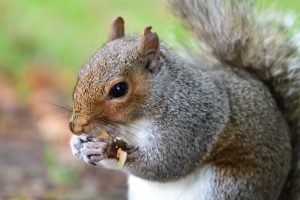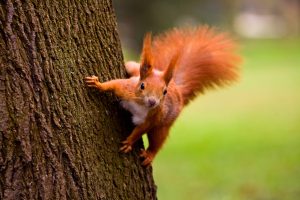Let's talk about your pest problem. Call Beaver Pest Control on 020 8355 3443 #
A-Z of Pests: Squirrels #
Beaver Pest Control are one of the leading expert pest control companies in the UK. Our goals are not only to provide effective pest control to our customers but also to educate everyone on the pests we deal with every day.
Why squirrel control is important? #
Squirrels that find their way into your property can cause a variety of problems. They are known to cause damage to property; gnawing on electrical wires, and damaging roofing and other parts of the building. They also carry health risks and can transmit diseases like rabies and Lyme disease.
Types of squirrels in the UK #
There are two main species of squirrels in the UK
Sciurus Carolinensis: The Grey Squirrel
Sciurus Vulgaris: The native Red Squirrel
The Grey Squirrel was introduced to Britain from North America on several occasions between 1876 and 1929. Since then it has spread throughout most of the UK with the exception of Northern Scotland and the offshore islands including the Isle of Wight. This has led to a decline in the population of the native Red Squirrels which are now a protected species.
Appearance #
The Grey Squirrel has a distinctive appearance. Their fur is greyish-brown with a white front. They are relatively small mammals with a body length of 20-25cm and tail length of 15-20cm. They have sharp claws for climbing and gathering food. As with other rodents, they have front teeth that are constantly growing, requiring them to gnaw on hard objects to keep them trimmed. Red Squirrels are slightly smaller and more slender than Grey Squirrels with a distinctive reddish-brown fur colour. Their tails tend to be bushier and they have smaller ear tufts.


Behavioural characteristics of rats #
Grey Squirrel (Sciurus Carolinensis)
Climbing: Grey Squirrels are well adapted for climbing trees. Thy have sharp claws and a flexible body allowing them to move quickly and easily through branches of trees.
Foraging: Grey Squirrels are omnivores and will forage for food in trees and from the ground which they will store in tree cavities or holes for later.
Nests: Grey Squirrels will build nests known as ‘dreys’ using leaves, twigs and other materials for warmth and shelter.
Mating and lifespan #
Grey Squirrels will use their drey for breeding. There are two breeding seasons each year. The first litters are born in February and March. The second litter are born in June and July.
Grey Squirrel | |
|---|---|
Sexually Mature | 7 – 12 months |
Gestation Period | 45 days |
Litter Size (average) | 1 – 7 |
Weaning Period | 10 weeks |
In captivity, Grey Squirrels can live up to 20 years old and have been known to live for 8 or 9 years in the wild but 99% will die before 6 years old in the wild.
Signs and traces #
Grey Squirrels are active in the daytime and are often seen or heard in attic spaces.
Grey Squirrel tracks are often visible in the mud or snow. They have four toes on the front feet and five on the hind feet making their tracks very distinctive.
One of the most obvious signs is the nests created by squirrels known as dreys. Typically made from leaves, twigs and other materials, these can be easily seen in trees or in attics.
Grey Squirrels will leave small, dark, cylindrical droppings which are usually found on surfaces such as tree branches, rooftops or window sills.
Legislation #
The main legislation relating to Grey Squirrels and their control includes:
Destructive Imported Animals Act 1932: Grey Squirrels cannot be kept in captivity without a license.
Wildlife and Countryside Act 1981: If captured, Grey Squirrels must not be released back into the wild.
Wild Mammals Protection Act 1996: Prohibits cruel treatment of all wild animals, but allows pest control by humane means.
Animal Welfare Act 2006: Requires all captive animals to be treated humanely.
Spring Traps Approval Order 2021: Lists spring traps approved for use against Grey Squirrels.





